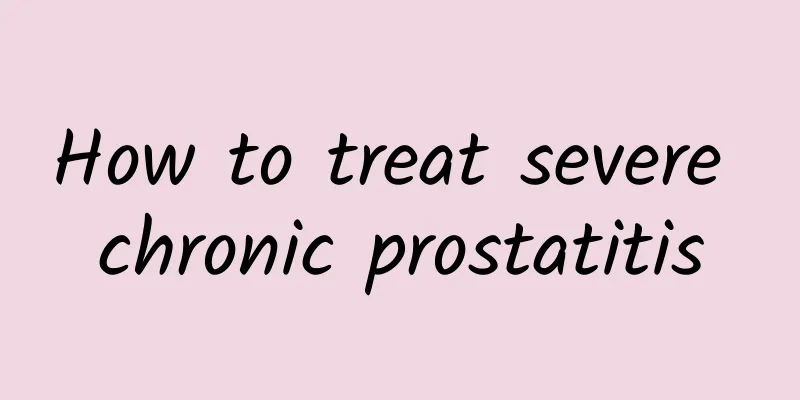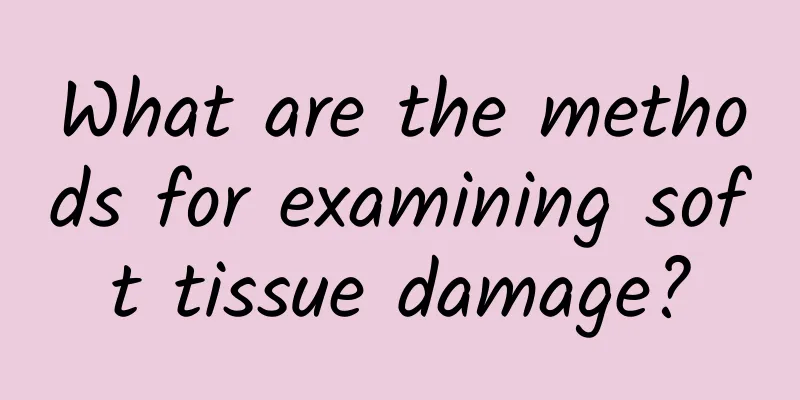How to treat severe chronic prostatitis

|
Prostatitis is a common disease among men today. It is divided into two types: chronic and acute. Both types of prostatitis are very harmful to men and have a great impact on their personal lives and married life. Therefore, the treatment of chronic prostatitis is also a hot topic in medical research today. The treatment of chronic prostatitis should mainly be based on medication, and it should also be combined with some personal attention. So how should severe chronic prostatitis be treated? The treatment goals of chronic prostatitis are mainly to relieve pain, improve urination symptoms and improve quality of life. The evaluation of treatment efficacy should be based mainly on symptom improvement. 1. General treatment Patients should conduct psychological counseling on their own, maintain a cheerful and optimistic attitude towards life, abstain from alcohol, and avoid spicy and irritating foods; avoid holding urine, sitting for long periods of time, and riding a bicycle or horse for long periods of time, pay attention to keeping warm, and strengthen physical exercise. 2. Drug treatment The most commonly used drugs are antibiotics, α-receptor blockers, herbal preparations and non-steroidal anti-inflammatory analgesics. Other drugs also have varying degrees of effectiveness in relieving symptoms. (1) Antibiotics: Currently, in the clinical practice of treating prostatitis, the most commonly used first-line drug is antibiotics, but only about 5% of patients with chronic prostatitis have clear bacterial infection. Chronic bacterial prostatitis: antibiotics are selected based on bacterial culture results and the ability of the drug to penetrate the prostate. After prostatitis is confirmed, the course of antibiotic treatment is 4 to 6 weeks, during which the patient should undergo periodic efficacy evaluation. Intraprostatic injection of antibiotics is not recommended. Chronic nonbacterial prostatitis: Antibiotic treatment is mostly empirical treatment, and the theoretical basis is to speculate that certain pathogens that are negative in routine culture cause the occurrence of this type of inflammation. Therefore, it is recommended to take oral antibiotics such as fluoroquinolone for 2 to 4 weeks, and then decide whether to continue antibiotic treatment based on the feedback of the efficacy. Only when the clinical symptoms are indeed alleviated, it is recommended to continue the use of antibiotics. The recommended total course of treatment is 4 to 6 weeks. (2) α-receptor blockers α-receptor blockers can relax the smooth muscles of the prostate and bladder and improve lower urinary tract symptoms and pain, thus becoming a basic drug for the treatment of type II/type III prostatitis. Different α-receptor blockers can be selected according to the patient's condition. The recommended α-receptor blockers are: doxazosin, naftopidil, tamsulosin and terazosin. The results of controlled studies show that the above drugs have different degrees of improvement on patients' urination symptoms, pain and quality of life index. (3) Plant preparations Plant preparations are increasingly valued for their therapeutic effects on type II and type III prostatitis and are recommended as therapeutic drugs. Plant preparations mainly refer to pollen preparations and plant extracts, which have a wide range of pharmacological effects, such as non-specific anti-inflammatory, anti-edema, and promoting bladder detrusor contraction and urethral smooth muscle relaxation. Recommended plant preparations include: Pusitai, Sabah palm and its extracts. Due to the large number of varieties, the usage and dosage must be determined according to the patient's specific condition, and the course of treatment is usually in months. Adverse reactions are relatively small. (4) Nonsteroidal anti-inflammatory analgesics Nonsteroidal anti-inflammatory analgesics are empirical medications for the treatment of symptoms associated with type III prostatitis. Their main purpose is to relieve pain and discomfort. (5) M-receptor blockers: For patients with prostatitis who have symptoms such as urgency, frequency and nocturia but no urinary tract obstruction, M-receptor blockers (such as tolterodine) can be used for treatment. (6) Antidepressants and anti-anxiety drugs For patients with chronic prostatitis who also have mood disorders such as depression and anxiety, antidepressants and anti-anxiety drugs can be used while treating prostatitis. These drugs can not only improve the patient's mood disorder symptoms, but also relieve physical symptoms such as abnormal urination and pain. When using these drugs, you must pay attention to the prescription regulations and adverse reactions of these drugs. The antidepressants and anti-anxiety drugs that can be selected mainly include selective serotonin reuptake inhibitors, tricyclic antidepressants and other drugs. (7) Traditional Chinese Medicine and Chinese Herbal Medicine is recommended to treat prostatitis with traditional Chinese medicine and Chinese herbal medicine in accordance with the relevant standards of the Chinese Society of Traditional Chinese Medicine or the Chinese Society of Integrated Traditional Chinese and Western Medicine. 3. Other treatments (1) Prostate massage Prostate massage is one of the traditional treatment methods. Studies have shown that proper prostate massage can promote the emptying of prostate gland ducts and increase local drug concentration, thereby relieving the symptoms of patients with chronic prostatitis. Therefore, it is recommended as an adjuvant treatment for type III prostatitis. It is contraindicated for patients with type I prostatitis. (2) Biofeedback therapy studies have shown that patients with chronic prostatitis have dyssynergia of the pelvic floor muscles or tension in the external urethral sphincter. Biofeedback combined with electrical stimulation therapy can relax the pelvic floor muscles and make them tend to be coordinated, while relaxing the external sphincter, thereby relieving perineal discomfort and urination symptoms of chronic prostatitis. (3) Heat therapy mainly uses the heat effect produced by various physical means to increase blood circulation in the prostate tissue, accelerate metabolism, and help reduce inflammation and eliminate tissue edema, relieve pelvic floor muscle spasms, etc. It has a certain effect in relieving symptoms in the short term, but the long-term effect is unclear. It is not recommended for unmarried and childless people. (4) The efficacy and safety of prostate injection therapy/transurethral prostate infusion therapy have not been confirmed. Chronic prostatitis, a major killer of diseases, must be treated seriously. The methods mentioned above, whether general treatment, drug treatment or other treatment methods, are what patients should remember seriously. According to their own disease conditions, they should be carefully checked and treated seriously. At the same time, they should have a positive attitude towards treatment, seriously cooperate with the doctor's requirements, strive to get rid of the disease as soon as possible, and make themselves more confident and energetic. |
<<: What are the benefits of eating pumpkin seeds for men?
>>: What to do if the glans gets inflamed
Recommend
What is the reason for the growth on the penis?
The penis is a very important reproductive organ ...
What to do if your feet sweat? Five tips to help you say goodbye to "stinky feet"
There are many small sweat glands in the feet, so...
Several folk remedies for treating men's snoring
I believe everyone must be very familiar with sno...
Will testicular pain go away on its own?
The testicle is a very important organ in men. It...
Is it bad to ejaculate every day?
Many men have doubts and concerns about whether e...
I used the delay spray and my glans became red and swollen
In order to delay ejaculation, many people will u...
Can premature ejaculation be cured on its own?
To deal with the problem of premature ejaculation...
What are the early symptoms of infection in men?
The male genitals are very susceptible to infecti...
What is the cause of blisters on the inner side of the foreskin?
We all know that maintaining good personal hygien...
Black itchy thigh root of male
If a man's thigh root is black and itchy, it ...
What are the symptoms of low blood sugar? These two are the most typical
For those with low blood sugar, corresponding sym...
What are the best treatments for prostate disease?
Many male friends have been affected by prostate ...
Hard lump at the base of the penis
If you find a hard lump at the base of the penis,...
Is frequent masturbation harmful to fertility?
Masturbation is a normal way for adult men to mas...
What are the methods for men to get rid of acne?
There are many ways to remove acne for men. Acne ...









